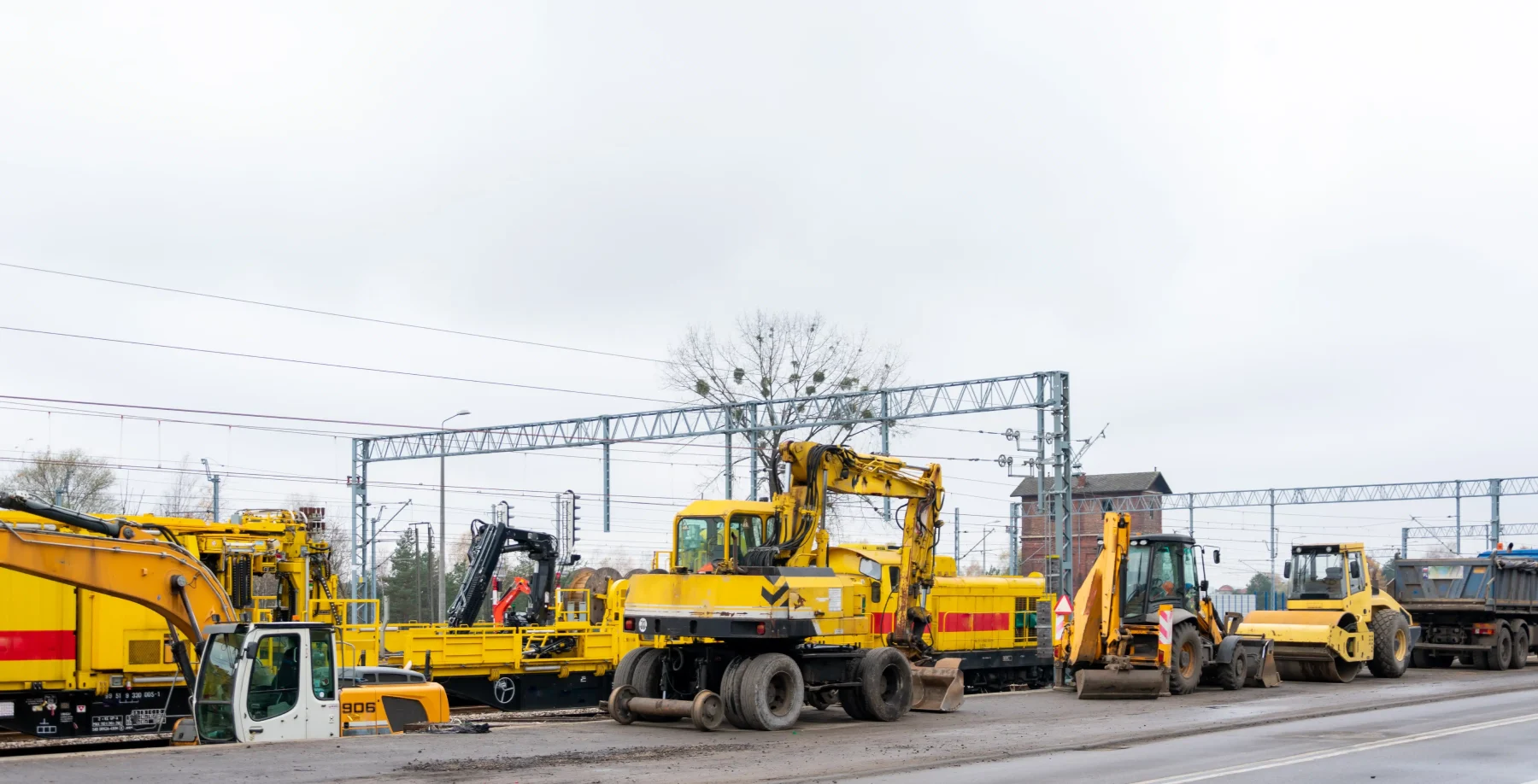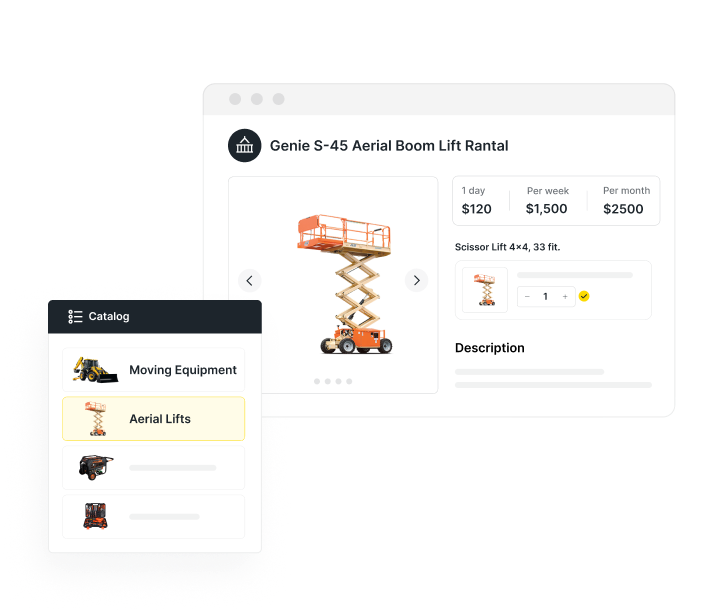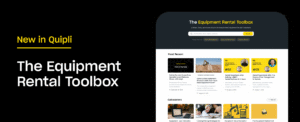The construction and equipment rental industry continues to experience unprecedented growth. While 2024 showed 8.2 percent revenue growth totaling $78.2 billion, projections for 2025 are more measured at 5.7 percent growth totaling $82.6 billion.
Without proper inspection protocols and tracking systems, even well-run rental operations can fall victim to what we call “rental gridlock.” This refers to the operational bottlenecks and inventory management challenges that prevent rental businesses from reaching their full potential.
By the end of this guide, you’ll have your equipment rental inspection process in place for seamless operations. Let’s dive in..
Table of Contents
- Downloadable Equipment Checklist Templates
- When Should You Inspect Your Rental Equipment?
- Key Things to Include in an Equipment Rental Inspection Checklist
- How Do I Keep Track of Rental Equipment?
- An All-in-One Equipment Check Process
Downloadable Equipment Checklist Tool & Template
We’ve created professional equipment rental checklist templates designed specifically for operators who need to maintain consistent inspection standards across their fleets. These aren’t generic forms. They’re battle-tested documents refined through real-world rental operations.
General Equipment Inspection Tool
General Equipment Rental Checklist
Our comprehensive equipment rental inspection checklist covers all standard rental equipment types. This template includes sections for pre-rental inspection, damage documentation, and return condition verification.
Key features include:
- Clear inspection categories with checkbox formats
- Space for photo documentation references
- Damage notation diagrams
- Digital signature fields for customer acknowledgment
- Professional Quipli branding that elevates your operation’s image
Download the Equipment Rental Inspection Checklist PDF
Heavy Equipment Inspection Checklist
This template goes beyond basic checks to include hydraulic system specifics, undercarriage assessments, and attachment compatibility verification. Check out the heavy equipment inspection checklist.
When Should You Inspect Your Rental Equipment?
Your rental fleet represents your largest capital investment. Protecting these assets while maximizing their earning potential requires strategic inspection timing.
Here’s the inspection schedule successful rental operators follow:
Pre-Rental Inspection (Mandatory)
Every piece of equipment must undergo inspection before leaving your yard. This baseline documentation protects you from damage disputes and ensures equipment safety. Even if a unit was returned an hour ago, inspect it before the next rental.
Post-Rental Inspection (Mandatory)
Immediately upon return, inspect equipment before the customer leaves. This real-time verification eliminates “he said, she said” disputes. It also allows immediate damage claim processing, protecting your revenue.
Mid-Term Inspection (For Rentals Over 30 Days)
Long-term rentals require periodic inspections to ensure proper maintenance and to catch developing issues. Schedule these at 30-day intervals or based on hour meter readings for equipment with high utilization.
Preventive Maintenance Inspections
Beyond rental-specific checks, integrate inspections with your preventive maintenance schedule. Use hour meter readings or calendar intervals to trigger comprehensive mechanical inspections.
Remember: Inspection frequency directly correlates with fleet availability. Equipment caught with minor issues during inspection stays rental-ready. Equipment that fails in the field creates downtime, emergency repairs, and unhappy customers.
Now that you understand when to inspect, let’s dive into what you should be checking.
Recommended Resource: The Most Rented & Profitable Construction Equipment
Key Things to Include in an Equipment Rental Inspection Checklist
A thorough inspection checklist eliminates guesswork and ensures consistency across your team. Every inspection should cover multiple critical areas to protect your assets and your business.
1) Basic Visual Inspection
Start with a complete walk-around examining the equipment’s overall condition. Document any existing damage with photos and note the general cleanliness level.
This sets the baseline for the entire inspection. Look for obvious issues that could affect safety or performance.
2) Tire and Track Condition
Proper tire and track maintenance prevents breakdowns and ensures safe operation. Your inspection should include:
- Tread depth measurements using a gauge (minimum 4/32″ for most equipment)
- Checks for cuts, bulges, or embedded objects
- Proper inflation verification according to manufacturer specifications
- Track tension, sprocket wear, and rubber pad condition for tracked equipment
3) Lights and Safety Equipment
Safety systems protect operators and your liability. Test all lighting systems including headlights, taillights, strobes, and work lights.
Verify backup alarms function properly. Check that required safety decals and manuals are present and legible. Ensure fire extinguishers are charged and inspection tags are current.
4) Undercarriage and Ground Engagement
The undercarriage takes tremendous abuse during normal operation. Inspect for:
- Hydraulic leaks or damaged hoses
- Loose components or unusual wear patterns
- Cutting edges and bucket teeth condition
- Non-OEM attachments that could affect warranty coverage
5) Hydraulic Systems
Hydraulic failures can be catastrophic and expensive. Examine all cylinders for leaks, scored rods, or damaged seals. Check hydraulic fluid levels and color—milky appearance indicates water contamination.
Test all hydraulic functions through their full range of motion. Document response time and any unusual noises that could indicate developing problems.
6) Brake Systems
Brakes are non-negotiable for safety. Test service brakes and parking brakes for proper operation. Check brake fluid levels and look for leaks at wheel cylinders or calipers.
For air brake systems, verify proper pressure build-up and test low-pressure warnings. Any brake issues should immediately flag equipment as “Hard Down.”
7) Attachment Systems
Improperly secured attachments cause accidents and damage. Your inspection must verify:
- Quick-attach mechanisms lock securely
- Pins and bushings show acceptable wear
- Auxiliary hydraulic couplers seal properly
- Attachment identification plates match inventory records
8) Engine Compartment
Check all fluid levels including engine oil, coolant, hydraulic fluid, and fuel. Inspect belts for cracks or fraying.
Examine air filters and note replacement dates. Look for any signs of leaks or unusual wear patterns that could indicate developing issues.
9) Electrical Systems
Electrical problems can sideline equipment instantly. Test the battery charge and connection security. Verify all gauges and warning lights function properly.
Check the hour meter reading and compare it to your records. Test any GPS or telematics systems to ensure they’re transmitting correctly.
10) Operator Station
The operator station affects both safety and productivity. Inspect these critical elements:
- Seat condition and adjustment mechanisms
- Control smoothness and proper labeling
- ROPS/FOPS certification currency
- Operator’s manual presence and legibility
11) Documentation and Compliance
Proper documentation prevents legal issues and ensures compliance. Confirm serial numbers match your records. Verify annual inspection certifications are current.
Check that transportation permits and registration documents are present. Ensure insurance documentation is available if required by your rental agreements.
With a comprehensive checklist in place, the next challenge is tracking all this information effectively.
How Do I Keep Track of Rental Equipment Easily?
Managing a construction or general tool rental fleet without proper tracking systems is like navigating without GPS. You might reach your destination, but you’re wasting time and resources getting there.
Modern rental operations break free from spreadsheet chaos by implementing integrated tracking systems and software, like Quipli. With the right tools in place, you can get insights and tracking into:
Real-Time Availability Management
Successful rental businesses maintain live availability across all locations. This means knowing instantly what’s available, what’s on rent, what’s in service, and what’s in transit.
Software that has equipment inventory management capabilities eliminate double-bookings and maximize fleet utilization by showing real-time status updates. Your team can make rental decisions confidently, knowing the system reflects current reality.
Serial Number Tracking
Every rental unit needs unique identification beyond just model numbers. Serial tracking allows you to:
- Monitor individual unit performance metrics
- Track complete maintenance history
- Calculate true ROI per asset
- Identify problem units before they become liabilities
This granular data drives better fleet management decisions and helps you optimize your inventory mix.
Location and Transfer Management
Multi-location operators need visibility into equipment movement between yards. Digital transfer workflows ensure units aren’t “lost” between locations. Software that has equipment dispatch management features will prevent one location from turning away rentals while another has idle equipment.
Maintenance Scheduling Integration
Link inspection results directly to work orders. When your team identifies issues during inspection, they should trigger maintenance workflows automatically.
This prevents small problems from becoming expensive failures. It also helps you track maintenance costs by unit, identifying equipment that’s costing more to maintain than it earns.
Digital Documentation
Replace paper inspection forms with digital checklists that attach directly to rental contracts. Benefits include:
- Photo documentation that can’t be lost
- Digital signatures with timestamps
- Instant access to inspection history
- Automated damage claim workflows
Digital documentation eliminates disputes and streamlines damage claims while reducing administrative burden.
Utilization Analytics
Track more than just rental days. Monitor revenue per unit, maintenance cost ratios, and time between rentals.
This data identifies underperforming assets and guides fleet optimization decisions. You’ll know exactly which equipment types generate the most profit and which drain resources.
While manual tracking can work for small fleets, growing operations need integrated solutions. That’s where technology becomes a game-changer.
An All-in-One Equipment Check Process
While checklists and spreadsheets can manage basic inspections, growing rental operations need integrated solutions that eliminate operational gridlock. This is where Quipli’s unified rental platform transforms equipment management from a bottleneck into a competitive advantage.
Transforming Inspections into Asset Intelligence
With Quipli, every inspection becomes a data point that improves your operation. The system transforms routine checks into actionable business intelligence.
Automated Status Updates
Status updates work seamlessly across your operation. When equipment is marked “Hard Down” during inspection, it’s immediately removed from availability across all sales channels. Your website, counter system, and partner integrations all reflect the change instantly.
Predictive Maintenance Triggers
This helps to prevent costly breakdowns. Set inspection points that automatically generate work orders. For example, use inspection checklists together with Scheduled Services and work orders to catch issues early and schedule maintenance before breakdowns.
Damage Documentation Workflows
Turn disputes into revenue. Photo evidence uploads directly to customer records. When damage is identified, you can log photos and notes on the order, create a work order, invoice the customer for repair costs, and track payment status from a single system.
Performance Analytics
Use data to drive smarter decisions. Use Quipli’s reports and exports to analyze inspection data, damage incidents, and maintenance costs by unit, so you can spot problem patterns and make smarter pricing and fleet decisions.
Mobile-First Inspection Tools
Your team shouldn’t be tied to a desktop for inspections. Field work requires field-ready tools. Quipli’s mobile capabilities allow technicians to:
- Complete inspections on tablets or phones
- Access complete equipment history in the field
- Process customer signatures digitally
This mobility ensures inspections happen when they should, not when it’s convenient to get back to a computer.
An All-in-One Equipment Check Process
With so much planning and commitment going into your equipment rental business, you should implement the best possible inventory and reservation management system.
Quipli provides equipment rental software that integrates your inventory with online equipment scheduling software, along with other benefits. You can reach out to our team today to book a demo and find out what Quipli can do for your equipment rental business.
Looking for more ways to grow your business? Learn more about equipment values and how to keep track of rental equipment with Quipli.







